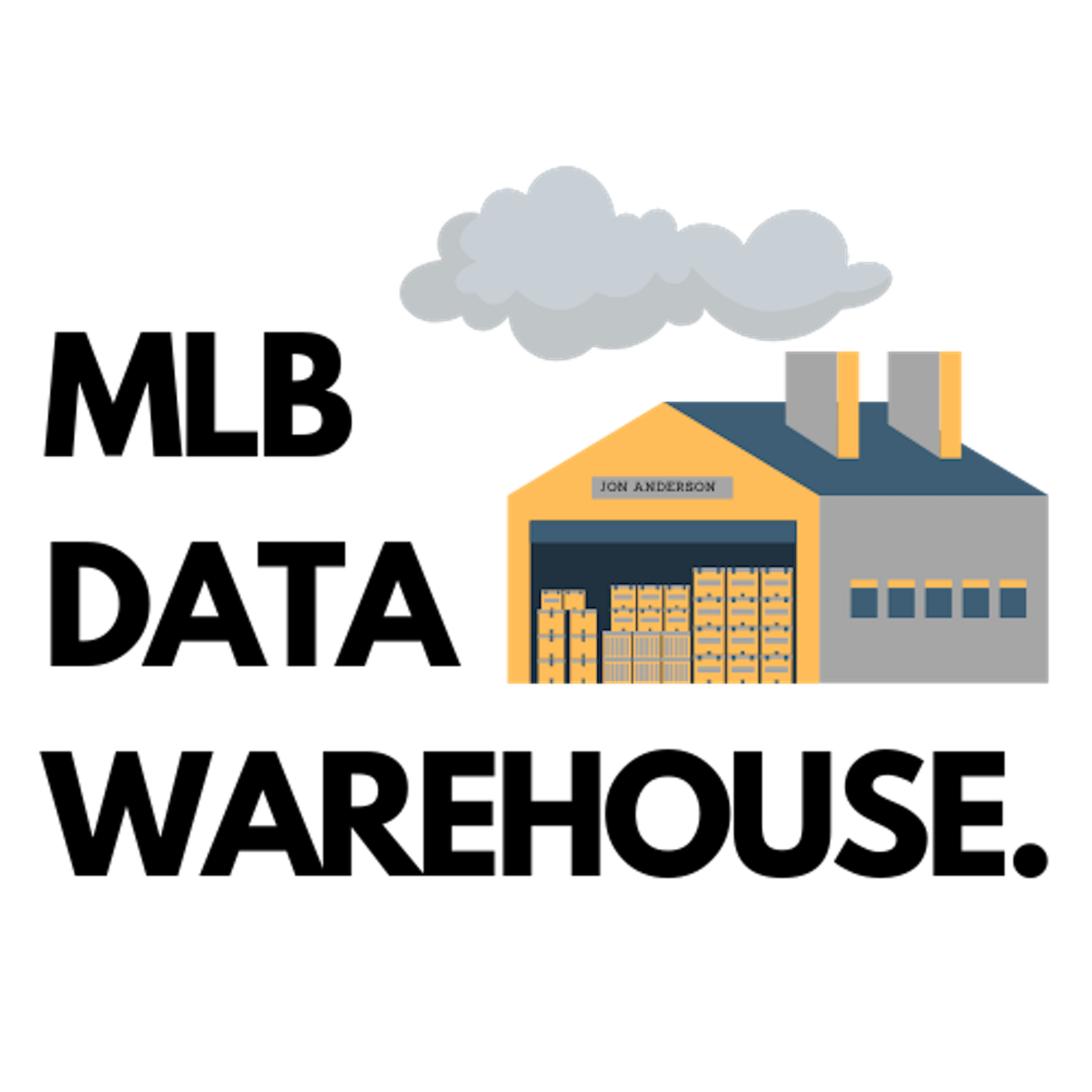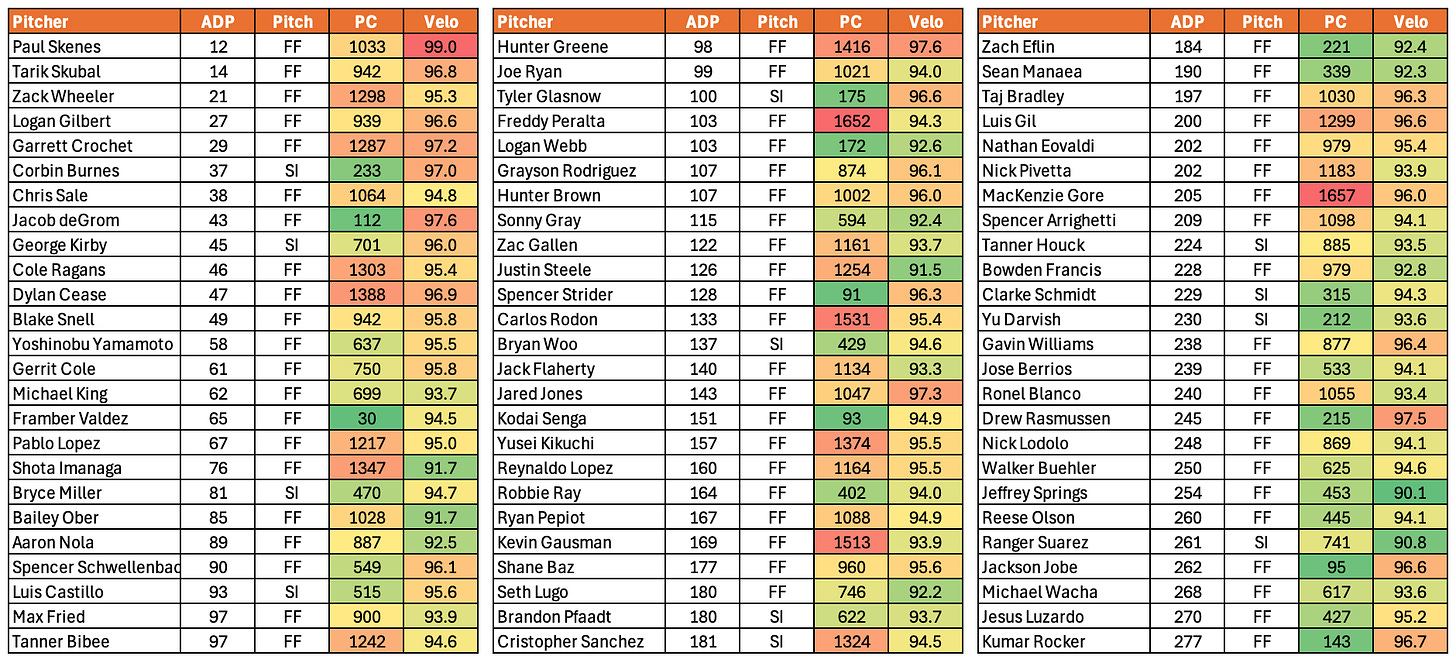The Play It Safe at SP Strategy
An approach to drafting pitching for those of you who never learned how to ride a bike
You have to risk it to get the biscuit. You won’t ever learn to ride a bike if you’re afraid to fall. Unless you’re my daughter, who just got on the bike and started riding it and never fell. But she’s the daughter of the best MLB projection man in the great state of Indiana, and not many kids have that kind of DNA.
We’re a few weeks into spring training now, so we’re seeing the starting pitcher towers begin to fall. Grayson Rodriguez, George Kirby, and Gerrit Cole were our first three victims, and there are many more to come. If you’re superstitious, maybe you should just avoid names that begin with the letter G…
Generally, I think you get yourself into trouble if you’re trying too hard to predict the future. There are people trying to draw lines about how hard you can throw your fastball before you get into some inescapable amount of injury risk. They say, “the human body wasn’t meant to throw 98 miles per hour 2,000 times a year!” as if the human was meant to throw 94 miles per hour 2,000 times a year.
I’ve also seen people saying it’s not about velocity but about effort. The high-velo guys are fine; you just want to avoid the guys who are throwing as hard as they can. Even if that’s true, how do you know the difference?
We are in the days of Big Data. I rent a freaking terabyte of data storage for like $5 a month. That’s absolutely unheard of. In high school, it cost me (aka my parents what up dad!) like $75 for a two-gigabyte flash drive. I think some of my kids’ toys have two gig storage.
This kind of data and processing power creates immense possibilities. But the main thing it does is make human beings wildly overconfident. I see this in the fantasy baseball space all the time. Everybody is trying to explain every little thing with data. We’re at the point where people are now trying to say things like BABIP and HR/FB are explainable and predictable by looking at pitch movement.
And look, 150 years ago, nobody thought it was possible to predict if it would rain tomorrow. The people trying were looked at as if they were mentally ill witch doctors (and okay, they probably were). But now we’ve gotten pretty good at it. Just because I sit here and say “this isn’t possible” does not mean the thing is actually not possible. What do I know?
I don’t know what’s possible. But I think I do know what we know is not definitely possible. That’s not a typo sentence; that’s what I meant to say.
We’re going to talk about pitchers now. My general preference is to stay mostly out of the waters of trying to predict injuries. These days, that means I’m more willing to take on perceived risk.
But I can make exceptions. I’m an open-minded guy. Last year, we saw a bunch of high-velocity elite fantasy starters get hurt. The correlation seemed to be there. Remember rule #1 in the statistics world: correlation does not equal causation. But I don’t think it’s insane at all to think velocity has some correlation to heightened injury risk. So let’s embrace that. Let’s take that assumption as true and then plan out a 2025 draft strategy that embraces it.
One thing I know is true is that a starting pitcher is much more likely to experience a season-ending injury than a hitter is. We have to say that using a premium fantasy pick on a starting pitcher is more likely to be a major bust than if you used the pick on a hitter.
An aside: the one thing I think people miss in this calculation is that this risk has a reward side. If you 7 of the top 10 SPs get hurt and you have one of the three that don’t, you’re well ahead of the league in pitching. You have one of the few true workhorse aces that don’t get hurt. I think that balances things out quite a bit, but I do understand not wanting to much of your championship hopes on a starting pitcher.
Even if injuries weren’t a consideration, I’d still rather start with hitters in the first two rounds. There are stud hitters early on that you just can’t replace. That’s not as much the case with pitchers.
Let us finally get to the point. If you believe in the velo = high injury risk idea, then you will not be wanting to draft these pitchers early on:
Paul Skenes (ADP 12, FB Velo 99.0)
Garrett Crochet (ADP 29, FB Velo 97.2)
Jacob deGrom (ADP 43, FB Velo 97.6)
Those are your three top-100 guys who averaged more than 97mph on their fastballs last year. Other guys who were between 96 and 97:
Tarik Skubal (ADP 14, FB Velo, 96.8)
Logan Gilbert (ADP 27, FB Velo 96.6)
George Kirby (ADP 45, FB Velo 96.0)
Dylan Cease (ADP 47, FB Velo 96.9)
Spencer Schwellenbach (ADP 90, FB Velo 96.1)
Hunter Greene (ADP 98, FB Velo 97.6)
After pick 100, I think you’re fine to just take the risk. You aren’t using a high pick to get Jared Jones (ADP 143, FB Velo 97.3) this year, so if you do lose him to injury, you’ll probably be fine. Probably every team in your league is going to lose at least one of their top four starting pitchers to injury at some point this year, so I think the upside with a guy like Jones justifies the cost.
Let’s go through a 12-team draft and build a pitching staff that takes on as little of this risk as possible. Here are the top-100 names who would seem to be “safe” (there is no such thing as a safe starting pitcher #TINSTAASSP), considering the type of analysis we’re doing right now:
Michael King (ADP 63)
Framber Valdez (63)
Pablo Lopez (73)
Shota Imanaga (78)
Bryce Miller (82)
Bailey Ober (88)
Aaron Nola (92)
Luis Castillo (100)
Joe Ryan (100)
You can grab two of those names between rounds five and nine and feel good. You might not actually be good, but at least you can feel good. And we play this game for fun, right? And fun is a feeling.
Let’s keep going through the next 100 picks in ADP and give you more “safe” names!
Freddy Peralta (103)
Logan Webb (103)
Hunter Brown (107)
Justin Steele (126)
Bryan Woo (137)
Jack Flaherty (93)
Robbie Ray (164)
Ryan Pepiot (167)
Cristopher Sanchez (181)
As I said with Jared Jones, there comes a point in the draft where the injury risk is worth it. To keep up that analogy, I’d say Jones has more upside than most, if not all, of those names.
The one issue with all of the names I’ve listed here is that there’s a trade off that comes with safety. Very few of these guys have the real ability to go win a Cy Young award. Velo = strikeouts. So if you’re playing in a strikeouts league (which almost everybody is), you are giving up strikeouts when taking on this perceived safety.
There are no solutions, only trade-offs.
-Thomas Sowell
The best way to go about this, in my opinion, is safety first, upside last. Take two of the guys in that first group I listed, and after that, stop worrying about it. Bring on the upside. Hunt for those guys who might just stay healthy and mow down hitters all year long. There’s no substitute for a 30% K%. And your roster is going to change a ton during the season anyway; it is worth embracing some injury risk as long as it’s not in the first few rounds.
Mock Draft
Let’s take this approach into a realistic 12-team league draft. You start your draft with five hitters
Round 1: Kyle Tucker
Round 2: Francisco Lindor
Round 3: Austin Riley
Round 4: Wyatt Langford
Round 5: Jose Altuve
Maybe you use that 5th pick on a closer if the league setup calls for that. Then you take advantage of that first group of SPs I listed.
Round 6: Michael King
Round 7: Shota Imanaga
Round 8: Ryan Walker
Round 9: Christian Walker
Round 10: Justin Steele
If it’s a standard league with waivers, you probably won’t have to burn a top-ten pick on a reliever, so you can start with your draft with a seven-hitter, three-pitcher split. You’re probably not going to run away with the ERA or strikeout crown taking this approach, but your offense is loaded, and you have some solid innings and pretty good ratios coming from those first three pitcher selections.
After that, you can feel free to take on some risk to try to add SP upside. You’ll have a ton of turnover in your rotation in a twelve-team league with daily or weekly waivers; embrace it!
You might be able to nab Shane McClanahan and/or Sandy Alcantara in rounds 11-12. Grab a Jared Jones, Kodai Senga, or Cristopher Sanchez in rounds 13-15.
Take some late shots on some of our favorites here, like Nick Lodolo, Gavin Williams, Jesus Luzardo, Jackson Jobe, Drew Rasmussen, Kumar Rocker, etc. Be prepared to replace guys and to be the first one to get on waivers picking up those early season breakout SPs.




Jon, nice article, helpful! Bu, may I ask why some of the second or third group guys are currently ranked higher that the first group of guys. Do we go after your 1st Tier recommendations or stick to the rankings. For example: You have McClanahan at #19 but Miller, Ober, Castillo and Nola below him in the rankings. Similarly, you have Alcantara at #23 but numerous 'higher tiered' guys below him. Thanks!